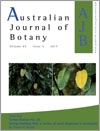This paper considers how far natural stands of eucalypt species are likely to be able to disperse in the period to 2085. Although rare long-distance events cannot be ruled out, the most likely dispersal distances are about 70–140 m. However, limitations such as inadequate remnant stands and extensive agricultural developments may reduce actual migration rates below even this modest potential.

Australian Journal of Botany
Volume 65 Number 5 2017
BT16257Influence of auxin and phenolic accumulation on the patterns of cell differentiation in distinct gall morphotypes on Piptadenia gonoacantha (Fabaceae)
The accumulation of IAA–phenolics was compartmentalised on the basis of gall morphotypes on Piptadenia gonoacantha. The sites of accumulation coincided with the most hypertrophied regions, i.e., the cells of superior and lateral inferior cortices in the lenticular galls, and throughout the outer cortex in the globoid galls, which influenced on the determination of the lenticular and globoid shapes.
BT17048Thermogenesis and developmental progression of Macrozamia macleayi pollen cones
The thermal activity of Macrozamia macleayi Miq. (family Zamiaceae) pollen cones changes with developmental stage in a manner similar to Cycas micronesica K.D. Hill (family Cycadaceae) pollen cones, suggesting a conserved physiological response across cycad families. The Macrozamia macleayi cones use carbohydrates, but not lipids, to fuel their large dehiscence stage thermogenic events, during which evaporation rates increase considerably.
BT16231Relationship between nitrogen resorption and leaf size in the aroid vine Rhodospatha oblongata (Araceae)
Although leaves of Rhodospatha oblongata increased 35 times in area and 50% in vein density, the N concentration was always around 2–3% in green leaves and 1–2% in senescent leaves. Consequently, increase in vein density or in the amount of leaf N content were not the main constraining factors to leaf nitrogen resorption.
BT17051Reproductive size thresholds and seedling survival in Acacia harpophylla (Mimosaceae)
The capacity of Acacia harpophylla (brigalow) to resprout on cleared land is well documented, but its ability to recruit new individuals sexually is poorly understood because such reproduction events are rare. This study, undertaken following widespread flowering in late 2007, recorded very high initial densities of germinated seedlings (46 000 seedlings ha–1 on average), but less than 1% were estimated to survive the first year. Given the dramatic over-clearing of brigalow, such ecological knowledge is crucial for managing remaining populations.
BT17054Nickel effect on root-meristem cell division in Plantago lanceolata (Plantaginaceae) seedlings
Plantago lanceolata is a variable species growing on different soils but is not abundant on serpentines. Nickel effect on root-cell division is the reason for the low percentage of divided cells, high percentage of abnormalities, and variation of karyotype morphology. Unsuccessful distribution of the species on serpentine soils is related to its poor adaptation to stress conditions provided by the elevated metal concentrations in the soils.
BT17089Aeluropus littoralis maintains adequate gas exchange, pigment composition and phenolic contents under combined effects of salinity and phosphorus deficiency
The ability of Aeluropus littoralis to cope with both phosphorus (P) deficiency and high salt stresses is a result of several mechanisms mainly involved in the conservation of the integrity of the photosynthetic apparatus. Secondary metabolites – mainly phenolic compounds and carotenoids – play an important role in the protection of A. littoralis plants against oxidative damage under combined high salinity and P deficiency stresses.
BT16252Adaptive strategy of tree communities on an environmental harshness hinterland inselberg in Minas Gerais, Brazil
Our research tested the hypotheses that environmental harshness enhances sprouting, a trait displayed by trees as an adaptive strategy to habitat persistence. Over the 5 years of the study, sprouting proved to be a strategy of persistence. Multi-stemmed trees have different dynamics compared to single-stemmed trees. Factors such as soil depth, may be the cause of sprouting in trees.
BT17043Regarding the structure and possible function of the columella in seed cones of Callitroideae (Cupressaceae): a morpho-anatomical approach
Several callitroid Cupressaceae have a column-like structure – termed ‘columella’ – that are developed distally in the seed cones, which exclusively represents the prolonged tip of the cone axis. Thus, the distal three-part structure of Fitzroya represents a sterile whorl of cone scales that should not be termed columella. It is suggested that columellae that exceed the ovules, play a role in the pollination process, whereas prolonged, resinous columellae play a role in the chemical defence against pathogens.



